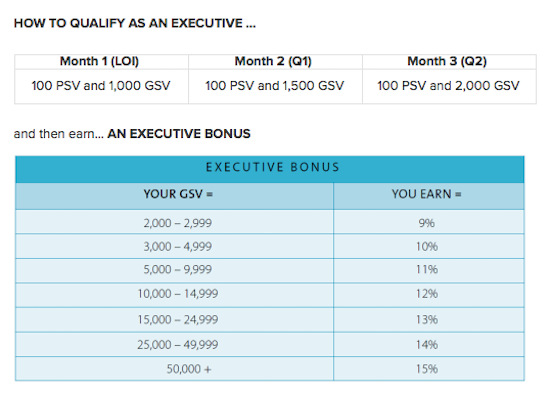How much can you earn with MLM Nu Skin?
How much can you make if you join MLM Nu Skin? Find out why, according to the company’s own income disclosure statement, 85% of distributors shockingly made no commission in 2017.
If there’s one common element between the commission schemes of all MLMs it’s their complexity. We wouldn’t be surprised if they were deliberately impossible to decipher to hide the fact that, according to research, it’s virtually impossible to make money with them.
And Nu Skin appears to be no different.
Indeed, searching through their website, financial reports and sales pages almost gave us a headache. Even their terminology changes (their shareholder report uses the term “Sales Leaders” for distributors who “achieve certain qualification requirements”, however this term doesn’t feature on any recruitment pages nor income disclosure statements), depending on the document.
However, we persevered to try to give you an accurate indication of what you can expect to earn with this side business if you decide to join Nu Skin. So let’s get started.
- How much does it cost to join Nu Skin?
- How you get paid commission at Nu Skin
- How much can you earn with Nu Skin?
- 85% of Nu Skin distributors earned NO commission
- How many US Nu Skin distributors earned nothing in 2017
- How much did people earn with Nu Skin in 2019?
- How Nu Skin “operated a pyramid scheme in China”
- Why Nu Skin is a “scam”
- Why Nu Skin has all five red flags for a ‘pyramid scheme’
- What’s the income opportunity promised by Nu Skin?
- But what about the Nu Skin millionaires?
- Some people DO get rich in MLMs (off the failure of others)
- Why we believe that MLM reps need to lie to recruit
- Why you should avoid MLM Nu Skin
Are you a freelancer who needs to send invoices? Check out the free invoice templates at sites like Vantazo.com.
How much does it cost to join Nu Skin?
Nu Skin distributors make a big fuss about how it costs nothing to join the company. And in one sense they’re correct. But if you join without paying, you won’t have any products to demonstrate or samples to offer potential customers. So how can you sell?
There’s a good reason why you (as far as we can tell – we found the information on their website confusing) don’t need to buy a starter kit to join Nu Skin in the UK. According to the DSA website, “The law governing Multi-Level Marketing does not allow an investment of more than £200 in the first seven days.”
However, Nu Skin’s cheapest introductory product package is an eye-watering £404.23:

So the real reason why Nu Skin doesn’t tie you into buying a starter kit to join is more likely to be because, as a DSA member, their introductory product packages are too expensive.
They do have another joining option for you, if you wish. You can choose to set up an Automatic Delivery Rewards (ADR), the cheapest of which is £152.65 a month:

Here’s what that £152.65 buys you:

(Yes, for £152.65 you get just FOUR products!)
When you sign up for an ADR you commit to receiving a package every month. And it’s billed, once you’ve joined, as “the easiest way for you to receive the products you love, and maintain your personal volume and eligibility.”
And while it’s very simple to sign up for an ADR online, and commit to giving Nu Skin your money every month, it’s not as easy to get out of if you change your mind. To cancel it you must give Nu Skin 14 days written notice.
Can you really earn £20k a month with Nu Skin? We put one Nu Skin rep’s boasts to the test here
You need to hit your Nu Skin sales target to get paid commission
Let’s return to the reason why Nu Skin promote ADRs as a benefit to distributors:
“Automatic Delivery Rewards is simply the easiest way for you to receive the products you love, and maintain your personal volume and eligibility.”
As you can read, as a Nu Skin distributor you need maintain a certain sales volume to be eligible to earn commission. So what is this volume?
Here’s what you need to achieve to qualify as a Nu Skin ‘executive’:

As with most MLMs, Nu Skin makes it hard to understand exactly how much you need to sell, by using a points system with terms such as PSV (personal sales volume) and GSV (group sales volume), rather than currency amounts.
However, this investigation into Nu Skin gives us an idea of the kind of sales you need to make to qualify:

This ties in with the cheapest ADR available in the UK being £152.65 – this could be the minimum amount a distributor needs to purchase from Nu Skin every month to qualify for commission.
(Nu Skin state that, “An Executive is required to meet monthly Executive Maintenance Requirements of minimum 100 PSV and minimum 2,000 GSV to maintain Executive position and to receive the Executive bonuses.”)
How much can you earn with Nu Skin?
So what, realistically, are your chances of actually earning as a Nu Skin distributor? To find out, let’s take a look at their 2017 income disclosure statement from the US to find out how much Nu Skin distributors are earning there:

An ‘active’ distributor is someone who actually qualified for commission in any given month.
As you can see, the average active distributor who hasn’t reached ‘executive’ level earned just $36 a month ($432 over the year) in commission. As with all income disclosure statements, this amount does not include their expenses.
It also doesn’t take into account how many of these products were bought by the distributor personally (including via the ADR they may have signed up to), just to enable them to remain ‘active’ and qualify for any commission at all.
Find out how the numbers Nu Skin share in their income disclosure statement contrast with their marketing messages in a video here.
85% of Nu Skin distributors earned NO commission
Like all MLMs, we can see from Nu Skin’s income disclosure statement that only the top tiny percentage of distributors earned anywhere near decent amount of money before expenses. Only the top 1.44% of active distributors made more than $912 a month (£10,944 a year) before expenses were deducted.
And if you wanted to earn more than $124 a month (again, before expenses) in commission you need to be in the top 7.49% of all active distributors in Nu Skin.
Not great odds, is it? And how many distributors weren’t able to qualify as ‘active’ in any given month? Research shows that an average of 99.6% of participants in MLMs lose money, and it’s easy to see, from statistics like these from Nu Skin, how this is possible.
But most interesting from this table, when you add up the percentages of distributor at each level, it only makes 15.42%. So where are the other 84.58% of active distributors? The answer lies here:

So, the reason why the income disclosure statement only mentions the earnings of 15.42% of distributors, is that the other 84.58% failed to qualify for ANY commission in this period.
That’s right, a whopping 85% of distributors earned nothing.
So what does the reality really look like for the average distributor? To give you a more visual picture of what the spread of Nu Skin commissions really looks like (and a more realistic idea of your chances of success with the company), here’s an infogram based on Nu Skin’s 2011 income disclosure statement:

55,911 US Nu Skin distributors earned nothing in 2017
Let’s break this down again by actual distributors. We know, from Nu Skin’s 2017 income disclosure statement, that they had 65,778 active US distributors during 2017.
Using their income disclosure statement, here’s what they actually earned:
- 55,911 people earned nothing.
- 8,525 people earned $36 a month.
- 1.368 people earned $124 a month.
- 243 people earned $56 a month.
- 2,341 people earned $481 a month.
- 710 people earned $912 a month.
- 473 people earned $1,506 a month.
- 184 people earned $2,798 a month.
- 92 people earned $5,325 a month.
- 78 people earned $9,252 a month.
- 118 people earned $43,298 a month.
Again, all of these ‘earnings’ are before expenses are deducted.
To any MLM apologist who tries to argue that every business is a pyramid scheme, we challenge you to look at those numbers and ask yourself whether the vast bulk of any company’s employees would earn nothing in a year, like Nu Skin. Or worse, once expenses are deducted, actually be in debt from their work.
And no, some people didn’t earn so little (or nothing at all) because they weren’t really in it for an income. Or because they didn’t work hard enough, or spend enough time on their ‘business’. We know from this recent survey into MLMs that the average monthly hours people work on their MLM business are 462.
Yes that’s 462 hours a month. And most of them will earn nothing for their effort, as we can see.
These appalling numbers simply reflect what we’ve seen in every income disclosure statement so far: the MLM model fails the bottom 99.6% of the earnings pyramid, on average.
How much did people earn with Nu Skin in 2019?
Since we initially published this article, Nu Skin have published their 2019 income disclosure statement. So we thought we’d take a look to update our figures.
And like other years, only a few people earned any money from Nu Skin in 2019. According to Nu Skin: “On a monthly basis, an average of 17.85% of U.S. Active Brand Affiliates earned a sales compensation payment.”
That means that 82.15% of Active Brand Affiliates earned nothing, which is similar to 2107.
Of those who did earn anything, the average monthly payment was $123.96. Although as Nu Skin points out, “these figures do not represent a Brand Affiliate’s profit, as they do not consider expenses incurred by a Brand Affiliate in the promotion of his/her business.”
It’s worth remembering the research published by the FTC that concluded that, on average, 99.6% participants in MLMs like Nu Skin will lose money when business expenses are taken into account.
And with Nu Skin having a monthly ‘active’ sales requirement, it’s easy to see how possible it is to lose money fast. We have yet to speak to a former MLM participant who didn’t personally purchase products to meet their active requirements – even women at the very top of the company, like this Younique Black Status Presenter.
That means that the 82.15% of Active Brand Affiliates who earned nothing a month on average quite possibly lost money after paying to qualify. And of those who DID qualify for a payment, the vast majority earned only $33 a month on average.
In fact, although Nu Skin tries to hide it by presenting their numbers differently, if you do the calculations, 66.8% of all Nu Skin Brand Affiliates who earned any money earned just $33 a month BEFORE expenses, including the cost of remaining active if you don’t make your quota of sales.
Does that sound like an attractive income opportunity?
How much did people earn with Nu Skin in 2021?
Two years on, we decided to see again what might have changed with Nu Skin. Here’s what Nu Skin’s 2021 income disclosure statement says:
“In the United States, the Company had an average of 83,242 Active Brand Affiliates during 2021. Active Brand Affiliates represented an average of 37.03% of total Brand Affiliates.”
What this means is that of all Brand Affiliates in the US, only 37.03% made any money at all. This is similar to 2017, when just 34.43% made any money at all. And remember: just because you aren’t earning money doesn’t mean you aren’t spending money on your business.
Of those who did make money, here’s what they earned:

Like other years, you can see that only a minuscule number of people at the top made much money at all. Tp put these numbers into context, let’s compare them to the average annual salary of a waitress in the US which, according to Glassdoor is $32,168 – or $2,680 a month.
According to their own income disclosure statement, if you want to earn the same as a waitress working for Nu Skin, you need to be in the top 0.93% of all people who made ANY money.
We estimate that to be 1,317 people. So of the 224,796 people who apparently tried to make money with Nu Skin in 2021, we calculate that just 1,317 people (or 0.59%) earned more than a waitress. Please bear that in mind if you ever consider joining the company.
Nu Skin “operated a pyramid scheme in China”
As you can see, like other MLMs we have investigated, Nu Skin’s income disclosure statement is pyramid-shaped, with a tiny percentage of people at the top earning the vast majority of the money.
So it wasn’t surprising to us to discover that Nu Skin was actually accused of being a pyramid scheme in China, and was apparently forced to “pay $47 million to settle a lawsuit that alleged the skincare products maker operated a pyramid scheme in China and made false and misleading statements about its operations in the country” in 2016.
The company was also fined $540,000 by Chinese regulators in 2014 for “selling products illegally and making product claims that it could not verify”.
Why Nu Skin is a “scam”
According to MLM expert Ethan Vanderbuilt, Nu Skin has also been in trouble in the US for false claims:
- In 1992, Nu Skin reached settlements with five states which had accused them of deceptive advertising and overstating the income earned by distributors.
- In 1994, following an investigation by the Federal Trade Commission (FTC), Nu Skin paid $1 million and signed a consent decree prohibiting it from making deceptive or unsubstantiated claims about its products.
- In 1997, Nu Skin paid another $1.5 million to the FTC to settle ongoing allegations of unsubstantiated promotional claims.
- In 2012, Nu Skin was exposed for double-listing distributors in the United States Million Dollar Circle to make it appear there were more successful distributors then there actually were.
Following Ethan’s extensive research (which you can read in full here), he concludes that
“In my opinion, Nu Skin is a product-based pyramid scheme. Each person who profits in the Nu Skin business opportunity does so primarily from the payments of others who are themselves making payments in order to obtain their own profit.
They have year after year used deceptive product claims and income claims to get people to join this scam. They hide retail sales information from new distributors. Over 85% of Active Distributors earn no commissions. Avoid this scam of a business opportunity.”
Nu Skin has all five red flags for a ‘pyramid scheme’
The Chinese regulatory authorities and Ethan Vanderbuilt aren’t the only ones to connect the P-word with Nu Skin. The website MLM -the Truth claims that Nu Skin has all “5 Red Flags for Identifying Exploitive Product-based Pyramid Schemes”.
Here are the five red flags that Nu Skin apparently satisfies:
- Recruitment of participants is unlimited in an endless chain of empowered and motivated recruiters recruiting recruiters.
- Advancement in a hierarchy of multiple levels of participants is achieved by recruitment, rather than by appointment.
- Significant requirements that participants “pay to play” the game via product purchases. Thus, new recruits are the primary customers.
- MLM company pays commissions and/or bonuses to at least 5 levels of participants, creating great “leverage” at the top. (Nu Skin uses a breakaway compensation system, with six levels of whole groups of participants, making it a mega-pyramid with one of the most extreme or highly leveraged compensation plans in existence. This is great for those at the top, but the pits for hundreds of thousands beneath them, who become its victims.)
- Most of the payout goes to the upline, rather than to the person selling products, creating excessive incentive to recruit and inadequate incentive to sell products (except to new recruits) – and an extreme concentration of income at the top of a hierarchy (pyramid) of participants.
MLM – the Truth says of the red flags:
“When these 5 red flags are all present, available data lead to the conclusion that the loss rate approximates 99.9% – far worse than the average 90% loss rate of clearly illegal 1-2-4-8 no-product pyramid schemes.
In other words, of all participants who sign up for such recruiting MLM programs, approximately 99.9% can be expected to lose money – especially if purchases from the company to qualify for commissions and advancement in the scheme are subtracted as a business expense.”
It’s this last sentence we want you to pay attention to particularly: “especially if purchases from the company to qualify for commissions and advancement in the scheme are subtracted as a business expense.”
Why? Because, remember, the Nu Skin income disclosure statement (in which 85% of distributors had earned nothing) didn’t take into account their business expenses. So the real truth is likely to be even worse that the numbers shown.
Indeed, as research by Jon Taylor, published by the FTC, discovered, an average of 99.6% of participants in an MLM will lose money, rather than earn anything, once expenses are deducted.
What’s the income opportunity promised by Nu Skin?
As we discovered when we looked into MLM Stella&Dot, and into the many lies that MLM reps have been caught out telling, there is often a huge discrepancy between what is promised to MLM recruits, and the reality of the ‘business opportunity’.
So what recruitment messages are Nu Skin distributors exposed to? And how do they compare to the company’s income disclosure statement that revealed that 85% of of distributors earned no commission?
According to this video, Nu Skin have “the greatest compensation plan in the history of network marketing.” They also claim to be making “a new millionaire every six days.” In five years, they claim they’ll be making a new millionaire every day.

So, on “the greatest compensation plan in the history of network marketing”, 85% of all distributors in the US earned no commission in 2017. If that doesn’t tell you all you need to know about MLMs, then we’re not sure what will convince you to avoid the MLM business model at all costs.
But what about the Nu Skin millionaires?
But what about the many Nu Skin millionaires that are being created? How do they fit into this picture?
While we can’t verify whether or not Nu Skin are indeed making a millionaire every six days, we can see that their biggest global presence is in Asia. And in many of these countries, being a ‘millionaire’ is far less impressive.
Here, to demonstrate, is their global market spread (taken from Nu Skin’s 2017 annual report):

Let’s see exactly how much you need to be a ‘millionaire’ in some of these countries. This is a million in each currency converted into GBP at the time of writing:
- In China you’re a millionaire with just £110,998
- In Taiwan you’re a millionaire with just £24,633
- In India you’re a millionaire with just £10,283
- In Japan you’re a millionaire with just £6,703
- In South Korea you’re a millionaire with just £673
- And in Colombia you’re a millionaire with just £251
So, as you can see, it is possible that Nu Skin is creating millionaires around the world. But it’s not quite as impressive as the video makes the feat out to be.
“You can earn $750k a year in two years with Nu Skin”
Earlier in this article, we referenced research by Jon Taylor, which was published by the Federal Trade Commission (FTC) in the US.
A successful salesman and entrepreneur, as well as college tutor on finance, entrepreneurship, and ethics, Jon Taylor was skeptical about recruitment-driven schemes (MLMs). However, after pressure from friends, in 1994 he decided to join one for a year as a test to see if the model worked.
He chose to join Nu Skin, as he considered it to be “one of the best of the MLMs” he could join.
And early signs were positive: he was told by the distributors who recruited him that those who recruited him that “with my capabilities and contacts, I could rise to the top level of “Blue Diamond” within two years – and that those at this exalted level averaged earnings of over $750,000 a year.”
Jon became a believer and embraced the company. He says that he “did everything my company and upline recommended – subscribed to and tried a wide range of their products, recruited people I knew, sought any referrals I could get, advertised after exhausting my “warm market” of friends and family, attended all the training and opportunity meetings (conducting some myself), and used my best efforts to train and motivate my recruits.”
It soon became apparent to Jon that, in order to rise to a level with decent commission earned, he would need to continue his aggressive recruitment campaign. This involved “luring prospects of the Nu Skin “business opportunity” to buy a “business in a box,” which consisted mostly of an expensive package of products to become a ‘business builder’.”
As recommended, he bought five of these packages for about $1,600 to jump-start five new recruits. This helped him advance up the distributor hierarchy through Nu Skin’s “fast start” program. (This is an example of the kind of expenses MLM recruits can soon add up in their quest to succeed.)
“I lost over $1,200 a month after accounting for all expenses”
After a few months, Jon rose to the top 1% of Nu Skin distributors. But he was paying a high price for his ‘success’. He was earning “pitifully small commissions” and his wife didn’t like the changes that were occurring in him and in their relationships with friends and family members, whom he was attempting to recruit.
Finally, at the end of the year she gave him an ultimatum: Nu Skin or their marriage.
As it turned out, it was an easy choice for Jon. Because, while he was in the top 1% of all Nu Skin distributors in the US, he was actually losing over $1,200 a month, after accounting for all expenses. These expenses included “purchases required to maintain qualification for the “Executive” level in the compensation plan – which was necessary to have any hope of profiting after expenses”.
It was this experience that led Jon into researching MLMs in depth, and the report published by the FTC.
Some people DO get rich in MLMs (off the failure of others)
But what of the tiny percentage of people who do appear to succeed in MLMs? Some of them may even be millionaires in currencies where it means something. At what cost does their success come?
As we can see, time and time again, from MLMs’ income disclosure statements, and in research like this (which shows the average participant in an MLM will earn as little as 67 US cents an hour before expenses), only the very tiniest fraction of a percentage of people who join an MLM make good money from their efforts (after expenses are subtracted).
And let’s be very, very clear here: their financial success is made off the back of the many, many, many more distributors underneath them who earn nothing, or even lose money in pursuit of their dream.
So the houses they boast about. The flashy cars they drive. And the designer handbags they show off on social media. These are all bought through the failure of others.
We believe that MLM reps need to lie to recruit
And, given the high turnover of reps that MLMs see (in Herbalife, for example, up to 90% of distributors below supervisor level apparently leave every year) they need new recruits to continually join the business. To invest in the starter kits. And to sign up for the ADRs in order for them to continue to receive their monthly bonuses.
So even if a high ranking distributor in an MLM knows the truth. Even if they know that 85% of people who join up under them risk not making any commission, they don’t say anything. And, as we have seen many times in MLMs, even if they know a new prospect doesn’t have the personality or network to make a successful go of the ‘business opportunity’ they’ll recruit them anyway.
And when these poor new recruits do indeed fail? They’ll be told they didn’t work hard enough. Didn’t have the right mindset. Or didn’t want it enough.
But the truth, as research into MLMs continually reveals is that it’s not the individual who failed. It’s the entire business model.
Why we think you should avoid MLM Nu Skin
So after our research, what’s our conclusion about Nu Skin, and the earning opportunity it presents? Unsurprisingly, it’s that it should be avoided at all cost! To recap, here’s why we believe this:
- 85% of all active distributors in the US earned no commission in 2017.
- This is before expenses were taken into account (meaning many of these will probably have lost money).
- Nu Skin was accused of being a “pyramid scheme” by Chinese authorities.
- It also paid $1.5 million to the FTC in 1997 to settle ongoing allegations of unsubstantiated promotional claims.
- The company apparently has all five ‘red flags’ for a pyramid scheme.
- It has been described as a “scam of a business opportunity” by an MLM expert.
Does that sound like a company you’d want to join? Or support by buying products from their distributors?
“Nu Skin may not legally be a pyramid scheme, but it has the same outcome.” Read another investigation into Nu Skin by The Overtake.
Read more about MLMs
We’ve an increasingly large library of MLM investigations and articles on our site. You can read more MLM income disclosures here:
- How can you make money with MLM LuLaRoe? Why the sums don’t add up
- How much money can you really make working for MLM Arbonne?
- How much money can you really make working for MLM Stella&Dot?
- Read the complete lowdown on MLM Juice Plus+
And more here:
- How much money can you really make working for MLM Herbalife?
- How much can you earn with MLM Younique? (Why it’s probably less than $14 a month)
- How much money can you earn with MONAT, the new MLM coming to the UK?
- How much money can you earn with MLM Isagenix?
Here some of our articles looking at the MLM business model:
- The 10 ugly truths MLMs don’t want you to know
- Fake it ’til you make it – how MLM reps lie to recruit and sell
- Thinking of joining an MLM? Read the truth behind the ‘income opportunity’
- Seven lies an MLM rep will tell you – and the REAL truth you need to know
And finally, some more:
- Is no tragedy safe from being turned into a sales opportunity by MLM reps?
- Why there’s no such thing as a free MLM car
- Are MLMs the modern day snake oil?
- Why any competition that allows MLMs is basically fixed
As with all our MLM income disclosure investigations, we have taken every care to ensure our Nu Skin calculations are correct. If we have made any errors, Nu Skin are very welcome to contact us and we will happily correct them.
Photo by Velizar Ivanov










